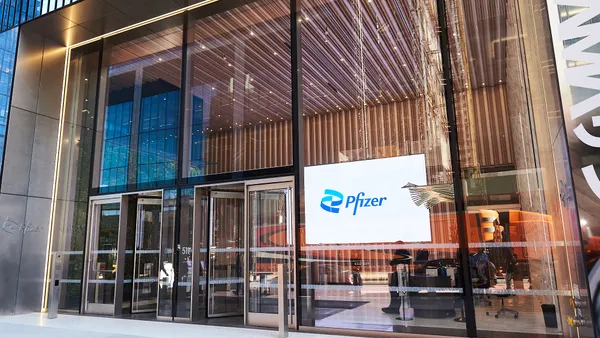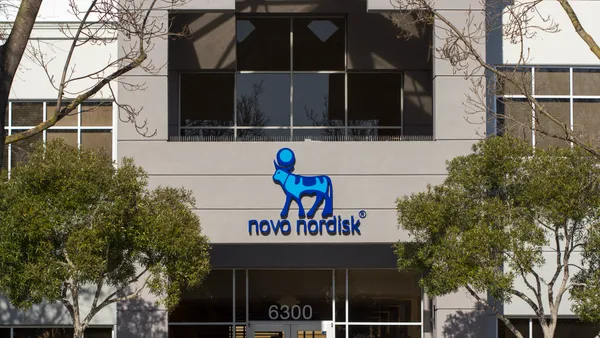BY KIM RIBBINK
A THOUGHTFUL ote considered approach to leadership has helped Ted Schroeder guide his team through ups and downs and set Cadence Pharmaceuticals on a defined path, one in which a vibrant culture and strong core values are the keys to its longterm success. N A A Photography by nathanpetty.com PV0308 LAYOUT 2/14/08 5:43 PM Page 58 59 PharmaVOICE M a r c h 2008 C TED Schroeder Carnegie Hall’s loss was the pharmaceutical industry’s gain. Growing up, Ted Schroeder had a passion for music, an interest that was fueled by his father and grandmother who taught piano. His goal was to become a performing musician after winning a competition that secured a scholarship to Combs College of Music in Philadelphia. While ultimately he abandoned his pursuit of a career as a concert pianist, music continues to play a large part in his life. It’s no coin cidence that the company he cofounded with Cam Garner in 2004 is called Cadence Phar maceuticals. In musical parlance, cadence means a particular series of intervals or chords that ends a phrase, section, or piece of music, while the term cadenza refers to an unaccom panied solo passage in a concerto. “The ancient Greeks taught music as one of the sciences, and I believe there is a strong connection between music and problem solv ing,” Mr. Schroeder says. “Playing music requires enormous discipline, a discipline that can be applied to many other endeavors. Music allows my creative side to think more broadly about problems; I believe there’s a connection between the two sides of the brain that allows one to move between the concrete and the more creative aspects of life. I’m not a linear thinker so music helps me think through problems and arrive at new solutions.” Creative problem solving is one of the hall marks of Mr. Schroeder’s leadership style. And he believes that it’s often the small lessons learned along the way that can have the most dramatic impact on how one interacts, per forms, and leads. As president and CEO of Cadence Pharma ceuticals, Mr. Schroeder takes a considered and measured approach that enables him to man age difficult situations as well as the good ones. He maintains an even keel by being non reactive as well as selfreflective. His willing ness to share information with his colleagues — be it good news or bad news — gives them confidence in the operations of the company. “No company can avoid having some bad news at some time or another,” he says. “I think being reactive stands in the way of finding solu tions. Honest, upfront feedback creates an envi ronment of trust as well as one of confidence. “When it comes to delivering bad news, I’ve never found it effective to couch the infor mation in a different light,” he adds. “In my experience, people always imagine the news to be worse than it really is, so it’s best just to let them know what’s going on.” When Cadence had some disappointing news from a clinical trial in early January, this is exactly the approach Mr. Schroeder took. He met with all of the employees to explain the data from the trial and what impact the results would have on the company and to answer any questions employees had. “If you walked into the company today, you wouldn’t think that just two months ago our stock price declined 61% in one day based on the trial data,” he says. “Our employees are upbeat, energized, and moving forward.” (For more information about Cadences programs and pipeline, see breakout on page 62.) Whether it’s a leadership style based on years of experience or a trait that is inherent in his easygoing nature, Mr. Schroeder encour ages those around him to stay positive and steer their energies to applying solutions. As the company, which focuses on the hos pital market, moves toward commercializa tion of products, its staff is ready to meet the challenges and opportunities that lie ahead. HITTING THE RIGHT NOTES Drawn to the pharmaceutical industry through an interest in science and an eagerness to work in a field that would, as he puts it, get him up in the morning, Mr. Schroeder joined BristolMyers Co. as a sales rep. He remained with the company, which later joined with Squibb, for 14 years. “Quite honestly, I didn’t envision ever leav ing BristolMyers Squibb; the environment was such that I was always learning and grow ing,” he says. “But things change and other opportunities came along that were too good to turn down.” While ultimately finding his niche in the small biopharma arena, Mr. Schroeder main tains that large pharma offers a wonderful training ground. “Big pharma companies devote a lot of time and resources to all aspects of training their people — human relations, coaching, business development, ethics, quantitative analysis, etc.,” he says. On the other hand, he says there is a great deal of bureaucracy, conservative decision making, and accountability issues because so many decisions in large companies are made by committees. “All these factors shaped my mind as I con tinued to grow and develop as a leader, and each experience drove me to think about more efficient ways of doing business,” he says. It was also at BristolMyers, in his early days as a rep, that Mr. Schroeder developed an appreciation for meeting the broad needs of the physician, including those who practiced in the hospital setting. “We handled a full range of products, from an overthecounter cough/cold remedy to an injectable antibiotic used principally to treat critically ill patients in the ICU,” he explains. “Working in this environment helped me to understand what prescribers valued, what they wanted, and how they thought about medica tions. It’s not enough for a company to have great science; it also has to offer solutions that enable physicians to do their jobs better, which is to take care of their patients. There’s a sym biotic relationship between industry and clini cians that can ultimately lead to a very positive and rewarding experience for the patient.” MAKING AN IMPACT Accountability and direct influence have become real drivers for Mr. Schroeder, and they impact the way he likes to work and lead. It was after leaving BristolMyers Squibb and joining a small company, Dura Pharmaceu ticals, that he had firsthand experience as to how significant one person’s decisions could be. “I remember clearly sitting in my office while working on some plans, and it occurred to me that I could calculate the impact of the Ted Schroeder There’s a symbiotic relationship between the industry and clinicians that ultimately can lead to a very positive and rewarding experience for patients. “ PV0308 LAYOUT 2/14/08 5:43 PM Page 59 60 M a r c h 200 8 PharmaVOICE TED Schroeder decisions I was making on earn ings per share,” he says. “This real ly excited me.” A willingness to embrace responsibility along with learning how to build culture in a company, motivate employees, execute against a strategy, and achieve goals convinced Mr. Schroeder that he had what it took to go solo. “I doubt that if I’d stayed at Bristol Myers Squibb or another large company that I would have founded a pharmaceutical company,” he says. “Helping build Dura through the highs and the lows in a concentrated period of time made me realize that there were lots of ways for a pharma company to be successful. There are big needs in the marketplace, and it’s not so mysterious that addressing unmet or under served areas generally provides a good return.” When it came time to make his move, he received invaluable support from Mr. Garner, who had been chairman and CEO of Dura during Mr. Schroeder’s tenure at the company. Mr. Garner had been and continues to serve as a mentor and a friend. He helped cofound Cadence and remains chairman of the Cadence board of directors. “I have enormous respect for Cam and knowing that I had his support and could count on his enthusiasm to found the compa ny made the proposition less unnerving,” Mr. Schroeder says. The entrepreneurial path has been exciting for the Cadence founders, though not without its difficulties. Mr. Schroeder says he and his executive team faced the same challenges that all start ups encounter — raising money, conducting due diligence, engaging the right advisors, and deciding on the right approach to take when the benefits to the company aren’t always obvious. But for Mr. Schroeder, one of the most significant challenges involves recruiting and retaining the right talent. “Start ups require people to take an enormous risk to join them,” Mr. Schroeder says. “And it’s not always possible to get it right. Saying goodbye to people who joined early on but who may not be the right fit as the company grows is never pleasant.” Now into its fourth year of operations, Mr. Schroeder is excited about the impact that Cadence and companies of its type can have on the market and patients. “Companies like Cadence serve an impor tant role in developing products that are important to patients but don’t necessarily have the blockbuster potential that the big pharma and biotech companies are pursuing,” he says. “Companies of our size can invest in and develop a product that may only be a $100 million to $200 million opportunity. It’s very difficult for a large company to divert resources into these types of smaller products. This is why this business model continues to work and attract investments and entrepreneurs, because our companies provide medications that patients need; they just hap pen to be for smaller patient populations than the next big cholesterol drug.” CULTURE COMES FIRST Cadence has grown significantly since its inception less than four years ago when it was an idea and had five employees. Mr. Schroed er, not one to rush headlong to the next step, was careful to establish the company’s culture first before moving to the next level. “We developed a culture focused on suc cess; one that was energetic, dynamic, and pos itive; and one that was true to our four core values: performancedriven, transparency, respect, and integrity,” he says. “As we grow, our focus will be on replicating this culture, hiring people who embrace our values, and ensuring that each employee becomes part of the cultural development of the organization.” The challenge, he says, will come when Cadence has more people working outside of its San Diego office than in it; and he has already given careful thought to how to navi gate those hurdles. “I view my leadership role as being the cul ture czar and making sure that if we begin to drift that we quickly make adjustments and continue to place our core values at the top of the pyramid,” he says. He seeks to nurture the culture through mentoring others and providing opportunities to his employees to excel. “I have frequent oneonone meetings with my direct reports,” he says. “I also try to give people a chance to lead, to interact with the TED SCHROEDER — RESUME STRIKING A CHORD 2004 — PRESENT.President,CEO,and Cofounder,Cadence Pharmaceuticals,San Diego,Calif. 2002 — 2004.SeniorVP,North American Sales andMarketing,Elan Pharmaceuticals,San Diego 2001 — 2002.VP and General Manager,Hospital Products Business Unit,Elan Pharmaceuticals 1999 — 2001. Senior Director, Acute Care Marketing,Dura Pharmaceuticals,San Diego 1997 — 1999.Associate Director, Injectable Antibiotics, BristolMyers Squibb Co., Plainsboro, N.J. 1995 — 1997.Senior Manager, Institutional Marketing,BristolMyers Squibb Co.,Plainsboro,N.J. 1988 — 1995. District Business Manager,New England,BristolMyers Squibb Co., Plainsboro, N.J. 1985 — 1988.Pharmaceutical Sales Representative,BristolMyers Squibb Co., Philadelphia EDUCATION 1985.B.S.Management,Rutgers University, Camden,N.J “ There’s a connection between the two sides of the brain that allows one to move between the concrete and the more creative aspects of life. I’m not a linear thinker so music helps me think through problems and arrive at new solutions. PV0308 LAYOUT 2/14/08 5:43 PM Page 60 PROMOTION WITH POWER Journal advertising increases physician awareness, product sales, and the likelihood that physicians will make your brand their product of choice. Shouldn’t your marketing mix include journal advertising? For more ideas on journal advertising, visit www.ammonline.org/MJA/. *Increase in message retention from 26% to 44% based on a sample of 18,250 physicians. Source: ACNielsen HCI. Your reps shouldn’t have to sell alone. With journal advertising, they don’t have to. When detailing is combined with journal advertising, message retention can increase 69% compared with detailing alone.* TODAY’S OFFICE CAN BE HARD ON REPS. DON’T SEND THEM IN THERE WITHOUT JOURNAL ADVERTISING. 9.00” live 9.50” trim 9.75” bleed 11.00” live 11.50” trim 11.75” bleed 227012a1 Pharmavoice 227012a1_AMM_AD_PhrmVc_D01:Layout 1 2/13/08 11:22 PM Page 1 62 M a r c h 200 8 PharmaVOICE TED Schroeder board, and to interact with the outside world. I promote their contributions and abilities and give advice where it’s appropriate.” Mr. Schroeder says one of the disturbing trends in the industry that runs counter to a strong culture is putting shortterm interests ahead of doing the right thing and laying blame when things go wrong. “These are areas of concern that have begun to affect the entire healthcare arena,” he says. “A case in point, is that the FDA is constant ly under fire. If the agency approves a drug and a rare side effect surfaces it is criticized for being sloppy, and if it doesn’t approve drugs in a timely manner based on everincreasing safe ty concerns, then there is criticism for keeping important medications from patients who need them. “The United States is the clear world lead er in biotechnology and pharmaceuticals yet we seem to be on a path that would dismantle our advantage,” he continues. “It would be a shame if, for shortterm interests, we crippled an industry that not only provides so many important medications but new learnings and new science to the betterment of mankind.”# PharmaVOICE welcomes comments about this article.Email us at [email protected]. Companyofficials believe there is enormous potential in the hospital market,given how few resources are directed toward it. IMS Health reports that about $28billion was spent onpro motional activities by the pharmaceutical industry in 2005. Of this amount, IMS estimates that only $1 billion (3.5%) was directed toward hospitalbased physicians and directors of pharmacies. In contrast, U.S. hospitals and clin ics accounted for about $54 billion, or 21%, of U.S. pharmaceutical sales in 2005, according to IMS.Thus Cadence views this marketplace as a compelling opportunity for a biopharmaceuti cal company commercializing its products directly through its own dedicated salesforce. The company has inlicensed rights to two Phase III product candidates, both of which have been studied in Phase III clinical trials. The first product is Acetavance, a formula tion of acetaminophen for intravenous use, which Cadence has exclusive license rights to in the United States and Canada. The product is currently marketed in Europe for the treatment of acute pain and fever by BristolMyers Squibb. If approved in the United States,Acetavance will allow physicians to take a multimodal approach to pain management that may result in reduced exposure to opioids and NSAIDS and result in better pain control. Cadence also inlicensed the exclusive North American and European rights to Omigard, a topical antimicrobial, for the prevention and treatment of devicerelated, surgical wound related,and burnrelated infections. “Omigard addresses a substantial unmet medical need in the United States in con trolling the primary cause o hospital acquired infections, central venous catheters, which is also a growing problem and reimbursement challenge for hospi tals,” Mr.Schroeder says. If all goes to plan,and the FDA approves the products,the company expects to hire a salesforce of between 150 and 200 reps, which would take the company to around 250 to 300 people from its current employ ee base of just less than 50 people. Cadence has enjoyed a period of sus tained growth, but on Jan. 11, the company announced that one of its Phase III clinical studies for Acetavance did not meet its pri mary endpoint of demonstrating a statisti cally significant reduction in patients’ pain intensity levels over 48hours comparedwith placebo, following abdominal gynecologic surgery.The study did, however,achieve sev eral secondary endpoints, including pain relief, global patient satisfaction, and time to rescue medication. A second trial of Aceta vance in fever met the primary endpoint, demonstrating a statistically significant reduction of fever over six hours compared with placebo.Both trials also demonstrated a good safety profile. CADENCE PHARMACEUTICALSWAS FOUNDED IN 2004TO FOCUSONTHEUNDERSERVED HOSPITAL MARKET.THE GOALWASTO PROVIDE ABROAD SPECTRUMOF PHARMACEUTICALSTO MEET ITS PARTICULAR NEEDS. A STRATEGIC APPROACH The companywas formed on a strategy, rather than a technology as is typical with most start ups. “The strategy was to address the hospi tal market with pharmaceutical products with a view of the hospital as a channel of distribution versus the more traditional approach of a therapeutic vertical,” Mr. Schroeder explains. While most companies in the hospital arena tend to focus on specific therapeutic categories — antiinfectives, cardiovascu lar, anesthesia — Cadence has taken a broader approach. “As long as a product is used primarily within the walls of a hospital,this is a market opportunity,” Mr. Schroeder says. “We get greater efficiency from our salesforce since our reps can move between departments more easily if they have multiple offerings. This is a very efficient business model.” In addition, Mr. Schroeder maintains it makes the company more attractive to the prescriber since Cadence can offer a broad er set of products. PV0308 LAYOUT 2/14/08 5:43 PM Page 62









